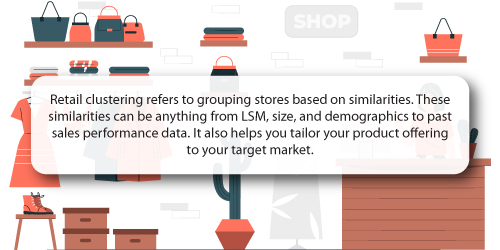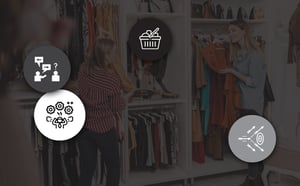If you're a retailer who has yet to begin to complete a clustering exercise, you're already at a disadvantage. Why? It's because of the increasingly competitive nature of the retail industry. Regardless of if you ignore clustering or forget it, in doing so, you miss out on many golden opportunities to beat your competition.

There is also the point that completing such an exercise allows you to drive more sales and profit across your retail business. Who wouldn't want that? Of course, it's not only about increased sales and profit. It's also about the long-term positive impact it can have on your business.

You’ll have too many products ranges that you can't manage effectively
If you ignore clustering, one of the first things you'll miss out on is the opportunity to reduce the number of ranges you have to manage.
Why is that a problem?
Let's say you don't consider category-based clustering (our preferred method). In such a situation, you'd end up stocking a different range for each store. Imagine running 22 stores and having to manage different ranges across each. Not only is that resource- and labour-intensive, but it's counterproductive.

Here's an example to explain it further. We'll use the Hair Care category and the products therein.
If you've located your store in an area where a significant percentage of shoppers buy ethnic hair products, you'd want to cluster this category with other similar stores. That includes stocking a range of products appropriate and attractive to this market.
By focusing on managing a select product range, you can ensure to personalise your assortment. When someone walks into your store with a specific item in mind, they can expect to find it.
It's the same if you have another store in a different area that caters to another demographic. You'd want to place the category in a cluster that allows it to range products specific to that market.
If you don't cluster, what you could end up with is ranging all sorts of products. And while you might be able to cater to your market in the short term, you'll soon find that you don't have enough stock of the correct items to meet demand, leading to stock-outs or overstock issues.
In going the clustering route, though, you're pleasing your customers and encouraging store and retail brand loyalty. The next time they're shopping for hair care products, they know they can go to your store at a specific location and get what they need.

You'll run the risk of range inconsistency across your stores
A knock-on effect of stocking too many products in a range is that you have every chance of ending up with an inconsistent product range across your stores.
In truth, you can all but guarantee that.
Stocking too many products means you're attempting to cater to everyone. That's wrong. Instead, you should choose your target market, understand what they need and optimise your range to cater to them.
Fortunately, completing a clustering exercise can help you correct this.
Because you must cluster according to similarities, a clustering exercise helps you spot and remove unnecessary products from your range. That means you can customise it according to the market you serve instead of taking a scattergun approach to your assortment.
Effective clustering helps you uncover opportunities to improve your ability to tailor your categories to the needs of your shoppers. Get complimentary advice from a DotActiv expert today to hear how our solution can help you achieve that.
In short, you take a strategic approach. By clustering according to similarities, you ensure range consistency across all the stores within a particular cluster that caters to a specific market.
Let's say, for example, you have six stores that stock Oral Health products, and you follow the category-based clustering method. Two stores cater to a demographic defined as middle class, while the other four cater to the working class.
By not completing a cluster exercise that considers any of the above information, you'll provide the same range to all stores.
In doing so, you'll stock too much of the wrong product, which impacts your ability to increase your sales and profits and grow your reputation as a store that is not worth visiting.
On the other hand, by implementing clustering, you can find out what range matches which store and offer consistency. If a shopper walks into any of your stores that cater to the middle class, having already visited a similar store before, they’ll know what to expect.

You’ll struggle to spot and capitalise on opportunity gaps in your range
As mentioned above, completing a clustering exercise allows you to discover if you've added any unnecessary products to your range. It also highlights items you should add to your range if they haven't already.
If you have found products that you can delist, you can remove them before they become a problem and take up space better served if given to products that offer you a good return on your investment.
The converse is also true. By not completing a clustering exercise, you'll struggle to spot these gaps. More importantly, your store may struggle with range bloat and have no solution to fix it.

So how can a clustering exercise help you spot opportunity gaps in your range?
When clustering stores, you would usually combine the sales of all stores in the cluster. That results in stores not carrying lines that perform collectively well to begin stocking these items, which allows them to capitalise on the opportunity gap.
Also, it allows you to tailor your range according to customer needs. That means you’ll end up with an efficient range that helps you to increase your sales and ultimately grow your retail business.
Here's an example:
A customer goes shopping for a 5kg bag of charcoal at one of your stores - Store A. However, the store doesn’t carry the item. They thus visit Store B for the item. They also happen to complete all their shopping at this new store.
While it’s still your retail brand, only a different store, Store A loses out on sales. The next time they go shopping, they might consider visiting Store B first, which means they’ve shifted their loyalty.
Considering both stores are located in a similar area, if you had clustered them to have the same range, you could have avoided such a situation.

You’ll frustrate any shoppers who enter your store
The best way to please your customers is to offer them the products they want at the right time and at the right price. That much is obvious.
Of course, while choosing the correct assortment for your target market can take you a long way, it's worth pointing out that you shouldn't attempt any assortment planning exercise without first deciding on how to cluster your stores. That's if you use specialist software such as DotActiv.
We’d also advise you to cluster your stores before choosing your assortment if you don’t use any category management software.
The only circumstance where you might get away with no clustering is if you don’t have many stores. In this context, we’re referring to having fewer than a handful of stores. However, that number is still up for debate.
That aside, deciding how you cluster your stores allows you to choose a range that speaks directly to the demands of your customers. That’s because the exercise includes looking at common demographics in the market, ensuring that you can choose a standard range that aims to serve the needs of your target market.
It's only after you've collected all the relevant information that you can realistically decide on your product assortment.
The result is a consistent shopping experience from one store to the next. What’s more, you can meet the expectations in terms of range carries and shelf and floor layout. When someone walks into your store, they’ll know what to expect. Moreover, if you satisfy one customer, you can ensure repeat business.
Customer satisfaction leads to increased customer loyalty, higher stock turns, and a boost in sales and profits. And that’s only the beginning. If you’ve approached it correctly, you’ll have created product category clusters that match your strategy and goals.

Conclusion
Conducting a clustering exercise is vital because of the positive impact on your retail business. Not only does it allow you to cater directly to the needs of shoppers, but you can also provide a better shopping experience. Fortunately, you don't need to do this alone.
Let DotActiv remove the uncertainty around clustering and tailor your categories so you can become known as the store where shoppers can find what they want.
To discuss your unique requirements and how our cluster optimization software and services can help you, book a complimentary meeting with a DotActiv expert here. You can also browse our software and service options on our online store here.


